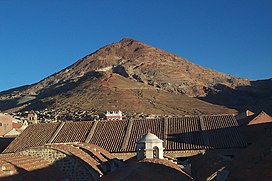
Back جبل جارجاميل ARZ Cerro Rico Catalan Cerro Rico (bukid sa Bolibiya) CEB Cerro Rico Danish Cerro Rico German Cerro Rico Spanish Cerro Rico Basque سرو ریکو Persian Cerro Rico French Cerro Rico Italian
| Cerro Rico | |
|---|---|
| Cerro Potosí / Sumaq Urqu | |
 View of Cerro Rico from Potosí | |
| Highest point | |
| Elevation | 4,782 m (15,689 ft) |
| Coordinates | 19°37′8″S 65°44′59″W / 19.61889°S 65.74972°W |
| Geography | |
| Location | Bolivia, Potosí |
| Parent range | Andes |
Cerro Rico (Spanish for "Rich Mountain"), Cerro Potosí[1] ("Potosí Mountain") or Sumaq Urqu[2] (Quechua sumaq "beautiful, good, pleasant", urqu "mountain",[3] "beautiful (good or pleasant) mountain"), is a mountain in the Andes near the Bolivian city of Potosí. Cerro Rico, which is popularly conceived of as being "made of" silver ore, is famous for providing vast quantities of silver for the Spanish Empire, most of which was shipped to metropolitan Spain. It is estimated that eighty-five percent of the silver produced in the central Andes during this time came from Cerro Rico.[4]
As a result of mining operations in the mountain, the city of Potosí became one of the largest cities in the New World.[5] It is said that revolutionary hero Simon Bolívar once waved a flag from the top of this monumental mountain in a historic moment that symbolized the founding of a new nation.[6] Just a year later, congress decided to change the colors to yellow-red-green and include a coat of arms featuring the iconic condor, alpaca and Cerro Rico mine.[7]
- ^ Cite error: The named reference
igmwas invoked but never defined (see the help page). - ^ Cite error: The named reference
choquewas invoked but never defined (see the help page). - ^ Cite error: The named reference
laimewas invoked but never defined (see the help page). - ^ Weatherford, Jack (2010) [1st pub 1988]. Indian givers: how Native Americans transformed the world (2nd ed.). New York: Three Rivers Press. p. 6. ISBN 9780307717153. OCLC 656265477.
- ^ Dore, Elizabeth (2000). "Environment and Society: Long-Term Trends in Latin American Mining". Environment and History. 6 (1): 1–29. doi:10.3197/096734000129342208. JSTOR 20723118.
- ^ "History: Flags of Bolivia & Coat of Arms".
- ^ "History: Flags of Bolivia & Coat of Arms".
